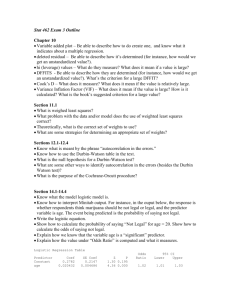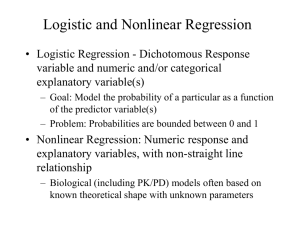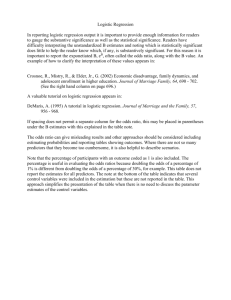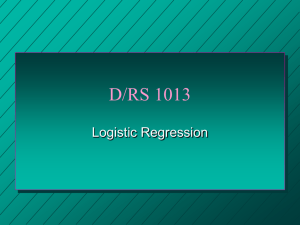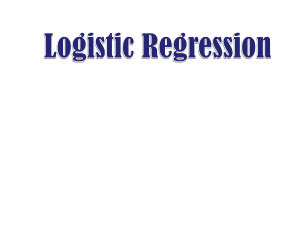Logistic Regression (WIP)
advertisement
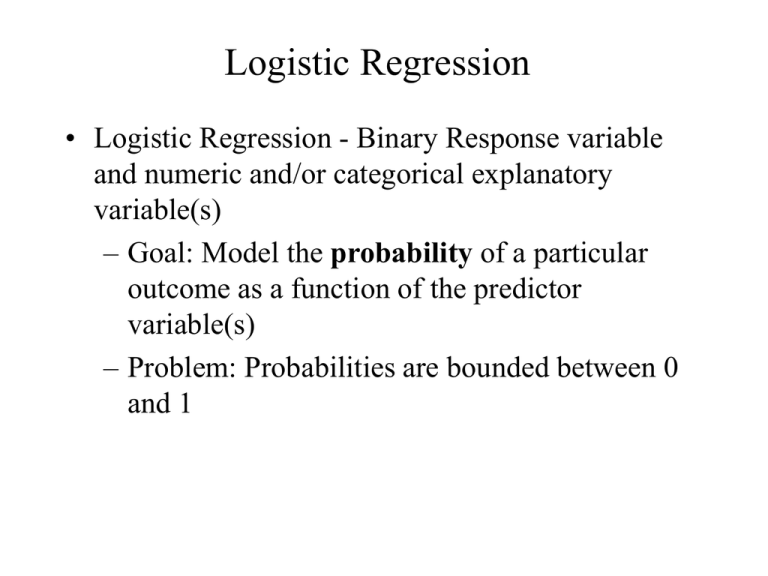
Logistic Regression • Logistic Regression - Binary Response variable and numeric and/or categorical explanatory variable(s) – Goal: Model the probability of a particular outcome as a function of the predictor variable(s) – Problem: Probabilities are bounded between 0 and 1 Logistic Regression with 1 Predictor • Response - Presence/Absence of characteristic • Predictor - Numeric variable observed for each case • Model - p(x) Probability of presence at predictor level x 0 1 x e p( x) 0 1 x 1 e • = 0 P(Presence) is the same at each level of x • > 0 P(Presence) increases as x increases • < 0 P(Presence) decreases as x increases Logistic Regression with 1 Predictor 0, 1 are unknown parameters and must be estimated using statistical software such as SPSS, SAS, or STATA · Primary interest in estimating and testing hypotheses regarding 1 · Large-Sample test (Wald Test): · H0: 1 = 0 HA: 1 0 b1 T .S . : X SE b 1 2 R.R. : X obs 2 ,1 2 obs 2 2 P value : P ( 2 X obs ) Example - Rizatriptan for Migraine • Response - Complete Pain Relief at 2 hours (Yes/No) • Predictor - Dose (mg): Placebo (0),2.5,5,10 Dose 0 2.5 5 10 Source: Gijsmant, et al (1997) # Patients 67 75 130 145 # Relieved 2 7 29 40 % Relieved 3.0 9.3 22.3 27.6 Example - Rizatriptan for Migraine (SPSS) t d B p . a ig E S D 5 7 9 1 0 0 a 1 C 0 5 6 1 0 3 a V 2.490 0.165x e p ( x) 2.490 0.165x 1 e ^ H 0 : 1 0 H A : 1 0 2 2 T .S . : X obs 0.165 19.819 0.037 2 RR : X obs .205,1 3.84 P val : .000 Odds Ratio • Interpretation of Regression Coefficient (1): – In linear regression, the slope coefficient is the change in the mean response as x increases by 1 unit – In logistic regression, we can show that: odds( x 1) e 1 odds( x) p ( x) odds( x) 1 p( x) • Thus e1 represents the change in the odds of the outcome (multiplicatively) by increasing x by 1 unit • If 1=0, the odds (and probability) are equal at all x levels (e1=1) • If 1>0 , the odds (and probability) increase as x increases (e1>1) • If 1< 0 , the odds (and probability) decrease as x increases (e1<1) 95% Confidence Interval for Odds Ratio • Step 1: Construct a 95% CI for : b1 1.96SE b1 b 1.96SE 1 b1 , b1 1.96SE b1 • Step 2: Raise e = 2.718 to the lower and upper bounds of the CI: e b1 1.96SE b1 ,e b1 1.96SE b1 • If entire interval is above 1, conclude positive association • If entire interval is below 1, conclude negative association • If interval contains 1, cannot conclude there is an association Example - Rizatriptan for Migraine • 95% CI for 1: b1 0.165 SE b1 0.037 95% CI : 0.165 1.96(0.037) (0.0925 , 0.2375) • 95% CI for population odds ratio: e 0.0925 , e0.2375 (1.10 , 1.27) • Conclude positive association between dose and probability of complete relief Multiple Logistic Regression • Extension to more than one predictor variable (either numeric or dummy variables). • With p predictors, the model is written: x x p p e 0 11 x p x p 1 e 0 1 1 • Adjusted Odds ratio for raising xi by 1 unit, holding all other predictors constant: ORi e i • Inferences on i and ORi are conducted as was described above for the case with a single predictor Example - ED in Older Dutch Men • Response: Presence/Absence of ED (n=1688) • Predictors: (p=12) – – – – Age stratum (50-54*, 55-59, 60-64, 65-69, 70-78) Smoking status (Nonsmoker*, Smoker) BMI stratum (<25*, 25-30, >30) Lower urinary tract symptoms (None*, Mild, Moderate, Severe) – Under treatment for cardiac symptoms (No*, Yes) – Under treatment for COPD (No*, Yes) * Baseline group for dummy variables Source: Blanker, et al (2001) Example - ED in Older Dutch Men Predictor Age 55-59 (vs 50-54) Age 60-64 (vs 50-54) Age 65-69 (vs 50-54) Age 70-78 (vs 50-54) Smoker (vs nonsmoker) BMI 25-30 (vs <25) BMI >30 (vs <25) LUTS Mild (vs None) LUTS Moderate (vs None) LUTS Severe (vs None) Cardiac symptoms (Yes vs No) COPD (Yes vs No) b 0.83 1.53 2.19 2.66 0.47 0.41 1.10 0.59 1.22 2.01 0.92 0.64 SEb 0.42 0.40 0.40 0.41 0.19 0.21 0.29 0.41 0.45 0.56 0.26 0.28 Adjusted OR (95% CI) 2.3 (1.0 – 5.2) 4.6 (2.1 – 10.1) 8.9 (4.1 – 19.5) 14.3 (6.4 – 32.1) 1.6 (1.1 – 2.3) 1.5 (1.0 – 2.3) 3.0 (1.7 – 5.4) 1.8 (0.8 – 4.3) 3.4 (1.4 – 8.4) 7.5 (2.5 – 22.5) 2.5 (1.5 – 4.3) 1.9 (1.1 – 3.6) Interpretations: Risk of ED appears to be: • Increasing with age, BMI, and LUTS strata • Higher among smokers • Higher among men being treated for cardiac or COPD
